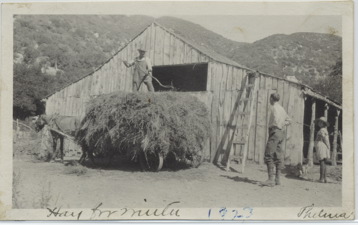Homesteaders
During the years that Lester was caring for his young family, city life provided employment, safety, and stability. But despite his success in the city, he was never truly happy there. The greed and self interest exhibited in the city dismayed him. Unable to change things for the better, he grew increasingly frustrated.
He loved the mountains, and spent his vacations camping, hunting, and prospecting in the peaks and valleys above Los Angeles. There he found the freedom, independence, and purity of life that he wanted. He first visited Alder Creek in 1891, and returned there each year to continue his exploration of the area.
During much of 1912, Loomis supervised construction of the Ridge Route portion of a natural gas pipeline being built between Los Angeles and the oil fields near Taft. As winter approached, he returned to his home in Los Angeles and began to make plans for his new life. His children were now grown - Anna, the youngest, was only seventeen, but Hazel and Ruth had recently married. By March, the Loomises had sold their home in the city and in April they began their adventure.
Lester had chosen the location of his new home carefully. When Charles Clark Vernon interviewed Grace Loomis in 1952 about those early years, he wrote the following description of their new homesite: "The location they chose was an ideal one; it was the very place to which the Captain had been coming for so many years. A broad level area extended for some distance on each side of the creek, yet the creek had a gully deep enough to prevent overflow and bad wash-outs in case of high water. The ranch site moreover was near enough to the head of the stream to further reduce danger from the periodic floods. In addition, the first harvest proved the fertility of the ground, and gold bearing ore was found near-by.”
It was an isolated spot. His nearest neighbor, Delos Colby, lived twelve miles away, a day’s hike, in Coldwater Canyon. There were no roads in the area. The Loomises brought all their supplies in by wagon from Acton to Mill Summit, and from there by pack train.

Tents next to Tom Clark's cabin, Alder Creek, circa 1913 (no date on photo)
Wandalee Thompson Collection, Sierra Madre Historical Archives (2004.14.9a)
The Captain’s life had prepared him well for building a home in the mountains. He had worked in construction and run a sawmill. He had been to the Yukon, where he had built a cabin for winter shelter. He had camped and hunted in the area for over twenty years. And he and his family were not afraid of hard work. They never intended that the Ranch would be a resort like many of the others located closer to the city. They were establishing a new home for themselves, far from city conveniences, so the Ranch had to be self-sustaining. They needed water, food, and shelter for themselves and their animals.
They lived in tents that first summer, and stored their supplies in the old Tom Clark cabin, still standing on the property. The first order of business was to clear land for planting and to build a permanent home. That first year, they cultivated about 2 acres consisting of alfalfa, some fruit, and a large garden. The cabin’s foundation was started in August, and finally completed in November, just before the heavy winter snows hit.
The following year, they had increased their planting to 5 acres, with about 125 fruit trees. In 1916, a total of 10 acres had been cleared and planted, yielding alfalfa, a variety of vegetables, fruit, and berries.
By 1917, the Loomises had built an irrigation system that included an 800 foot long concrete ditch, 500 feet of 5 inch iron pipe, and 700 foot of open dirt-lined ditch, a 16 x 20 foot barn, a corral, chicken and hog pens, and 1000 feet of brush fencing. It was a very busy four years.

Loomis Ranch barn, circa 1923.
Lester Loomis handles the pitchfork, while Thelma Thomas
and unidentified man look on.
Wandalee Thompson Collection, Sierra Madre Historical Archives (2004.14.2)
In addition to their physical work, they also had to deal with the government bureaucracy required to claim their land. Shortly after they arrived, on June 13, 1913, an initial survey was performed. The initial survey was for approximately 77.5 acres of land.
A year later, on August 22, 1914, the government officially requested than the land be opened for settlement, and Loomis filed his Homestead Application on 12/14/1914. On December 15, 1917, he submitted his Final Proof and received his Certificate. His land patent was approved on January 22, 1919, and finally, on June 17, 1919, President Woodrow Wilson signed Land Patent 687185 for just under 77 acres on Alder Creek. The home that they had worked so hard to build was officially theirs.
[Initial Version: 02/01/07]
[Sources: Lester Loomis Journals, LA Times articles]